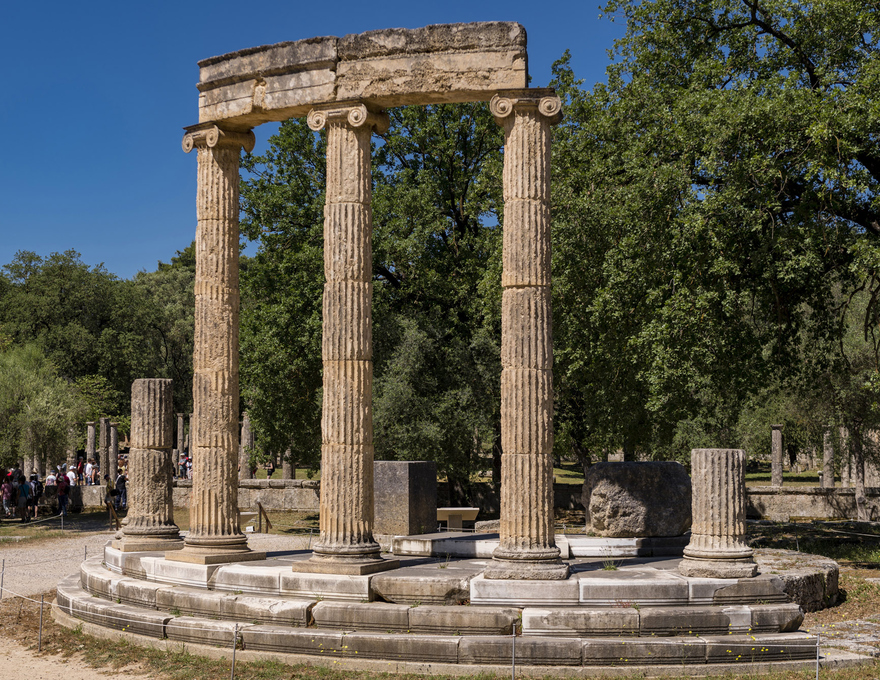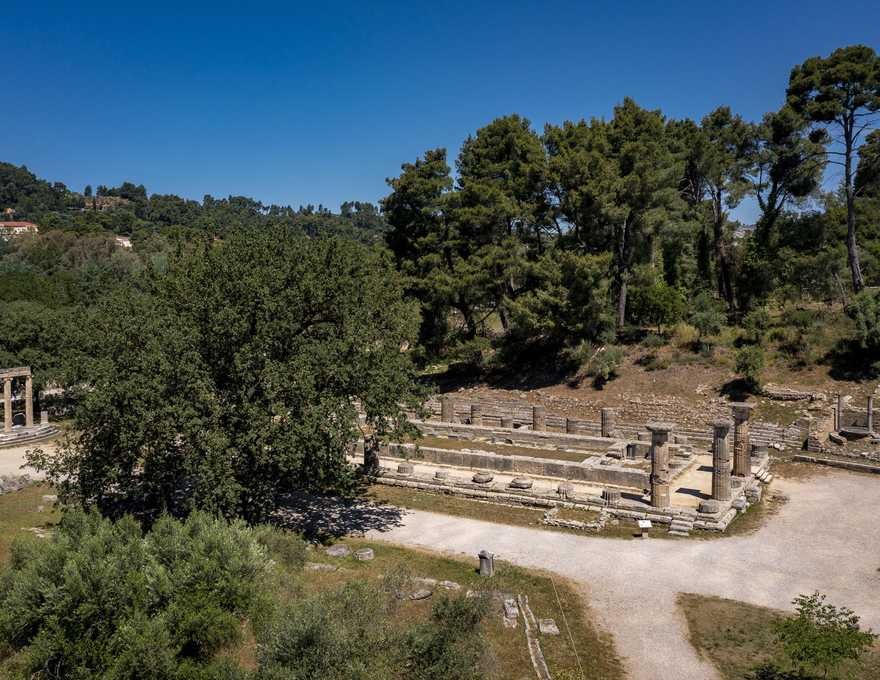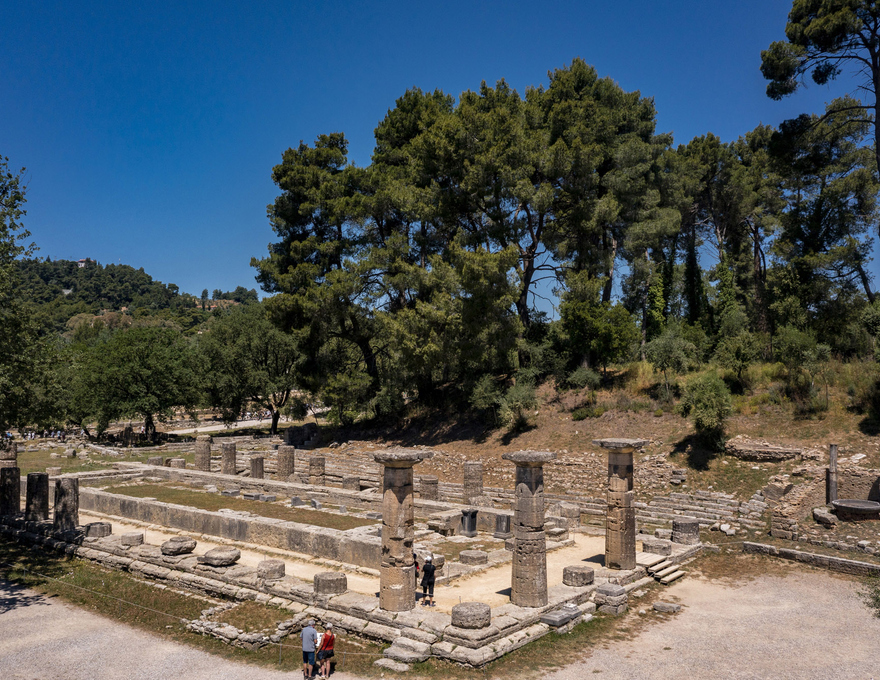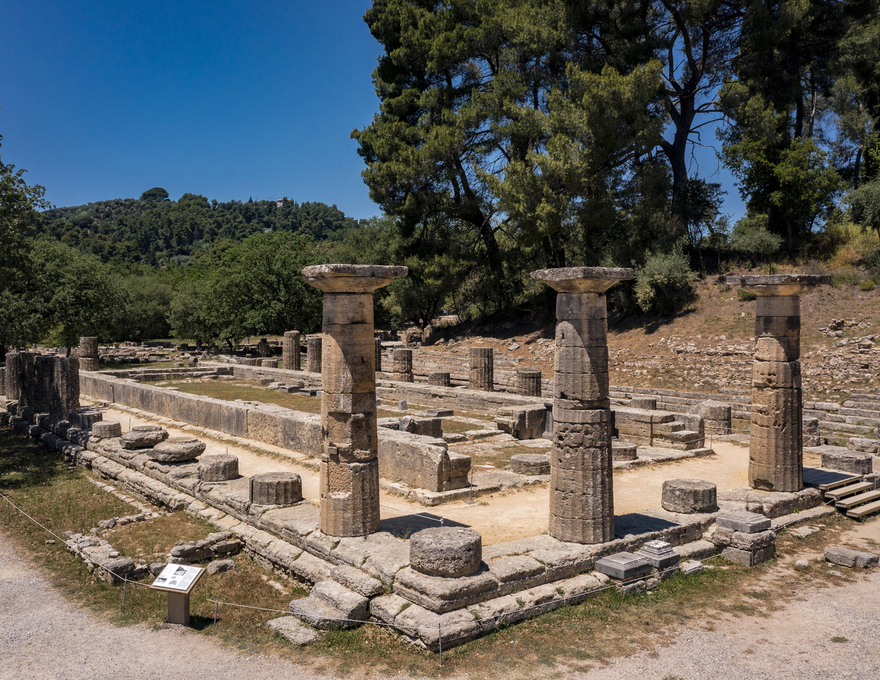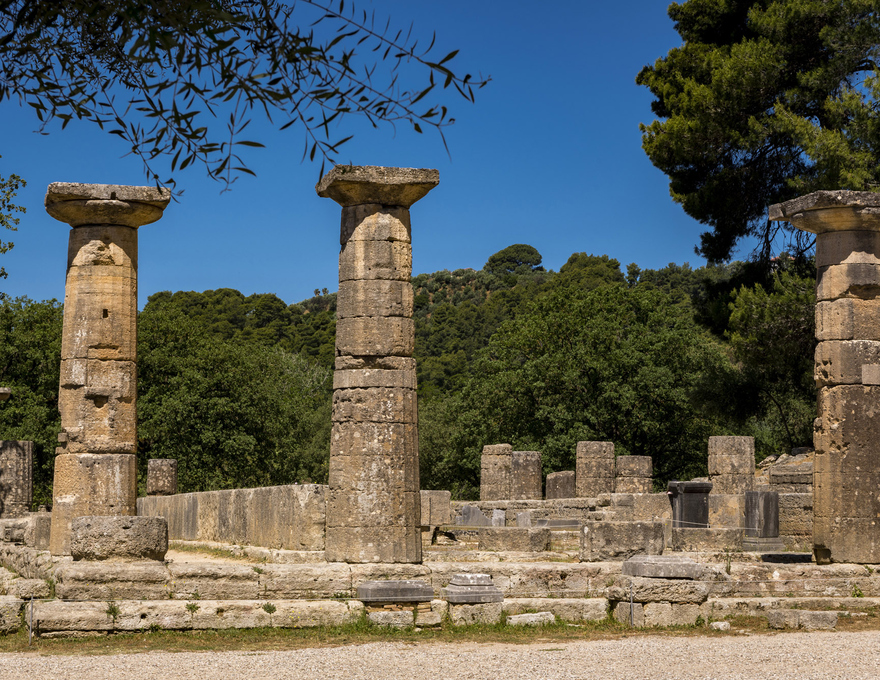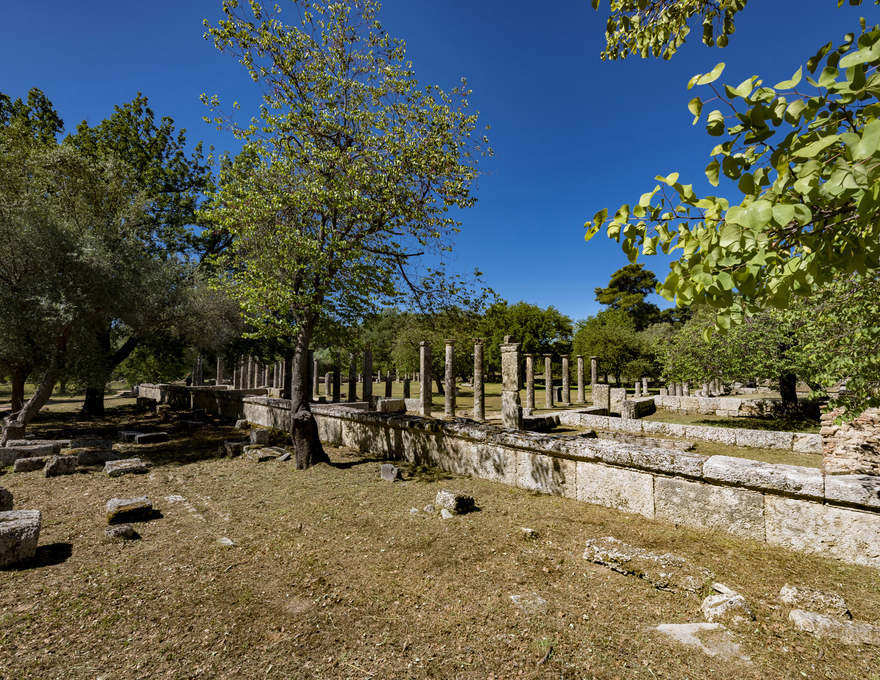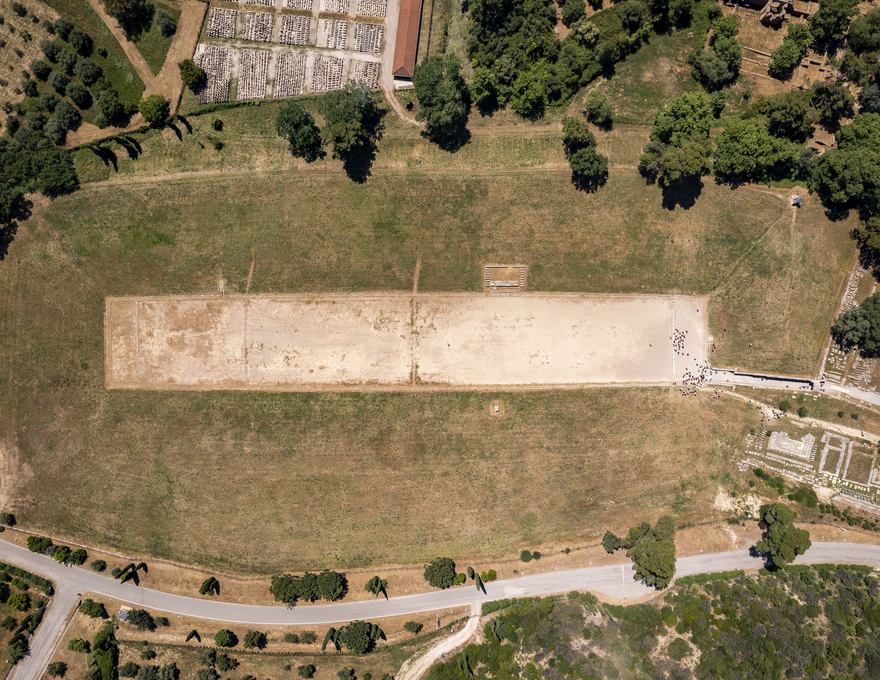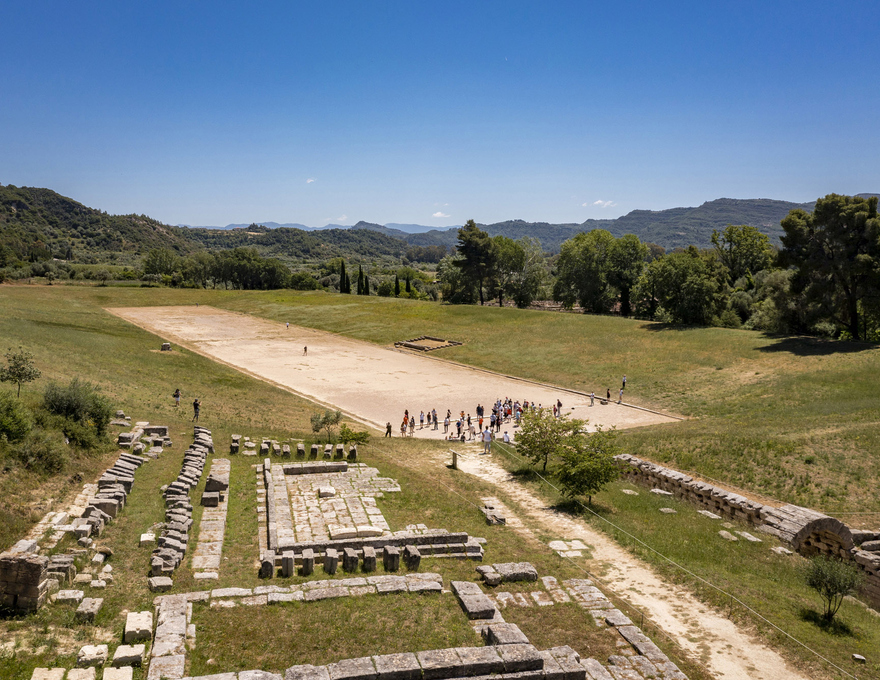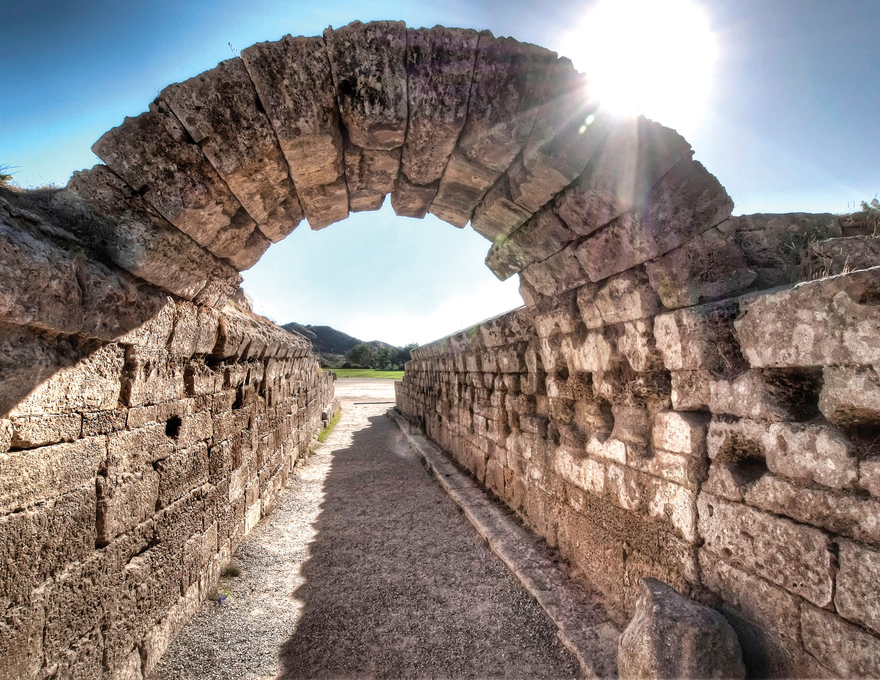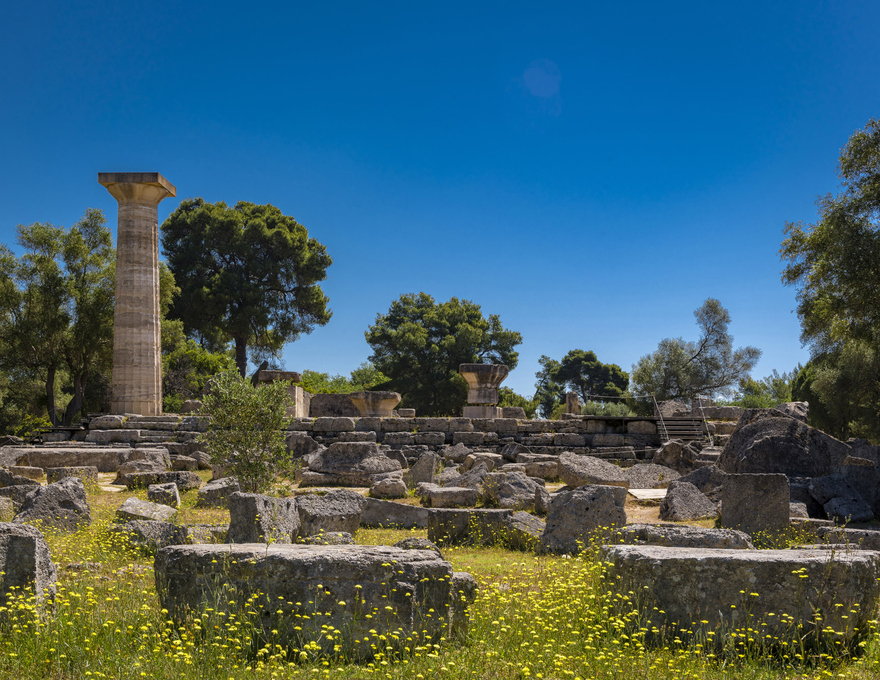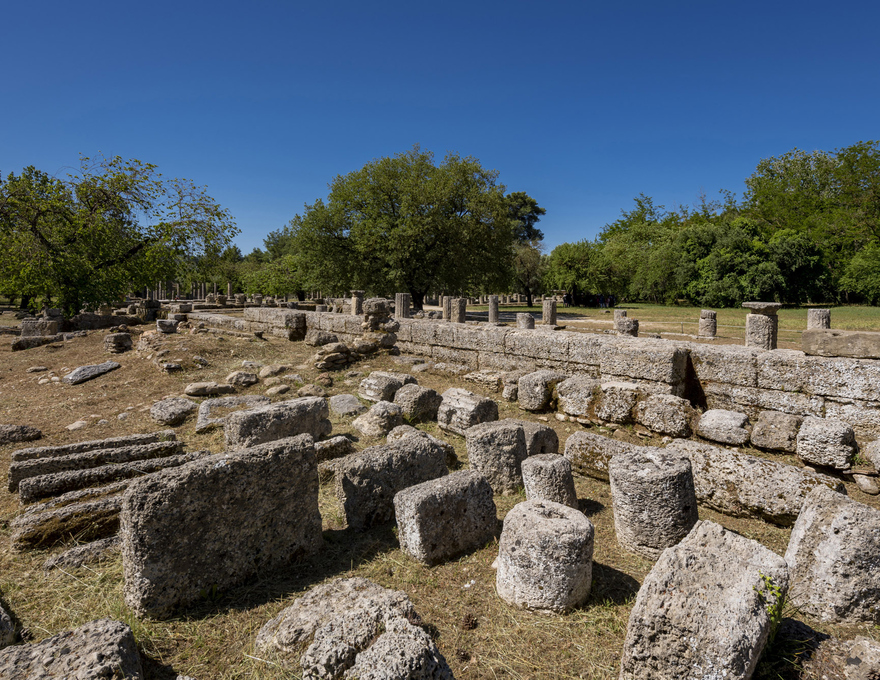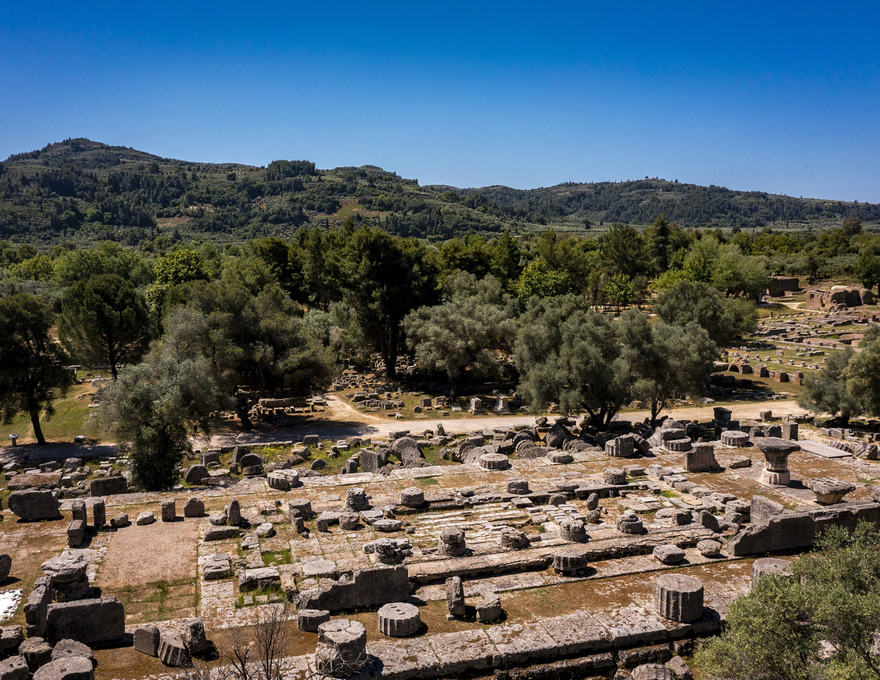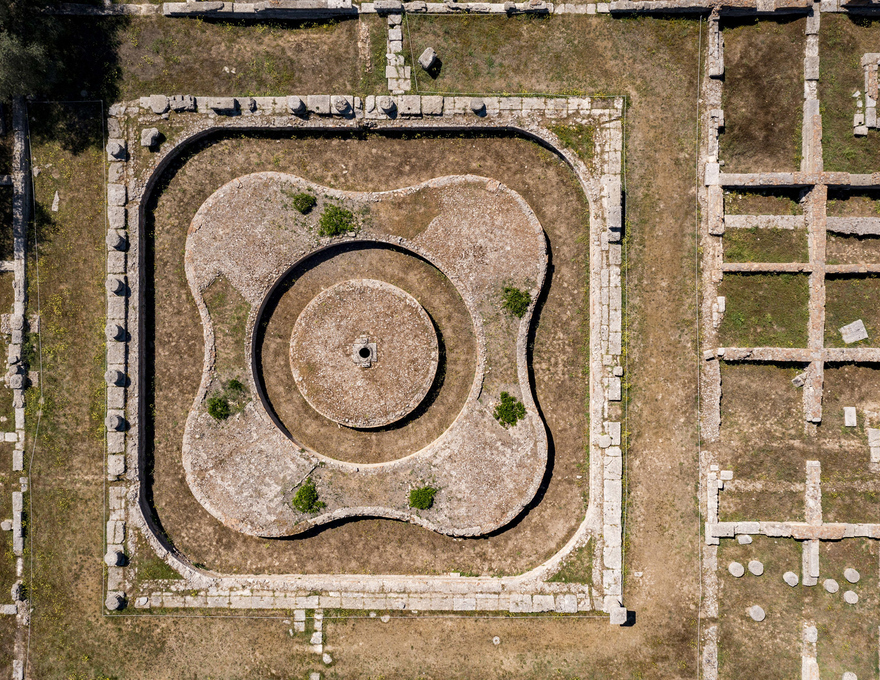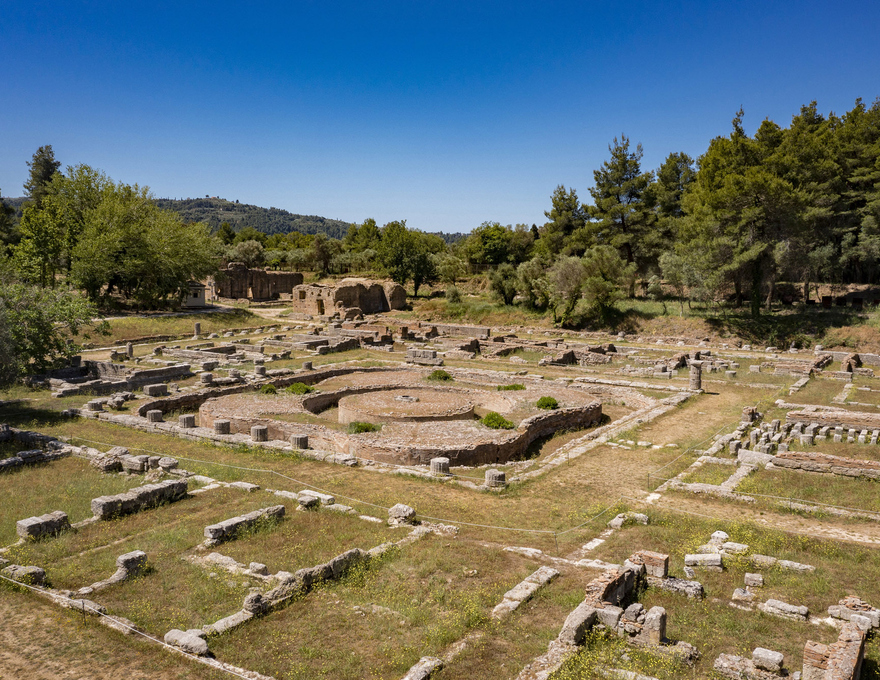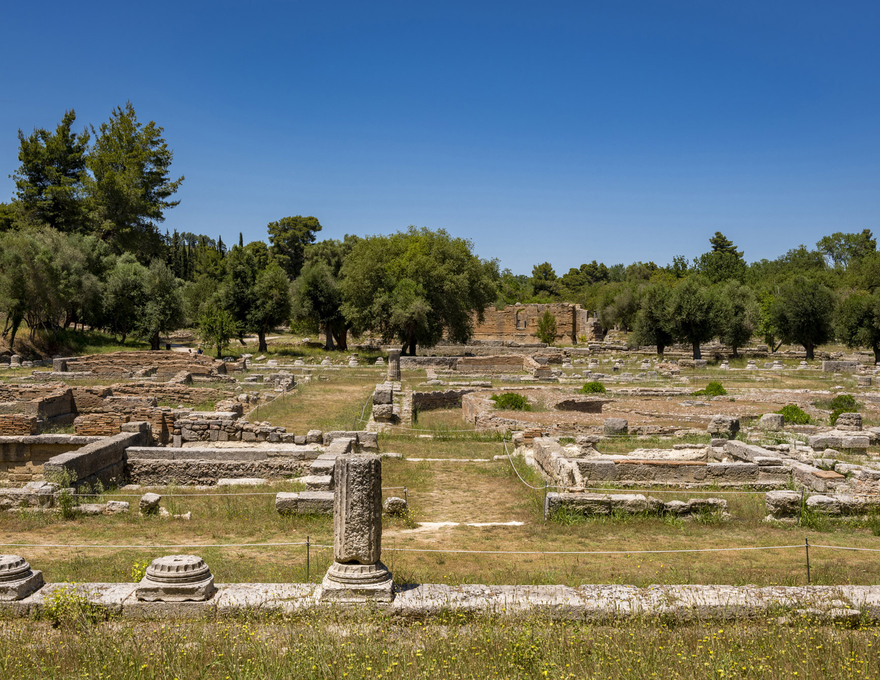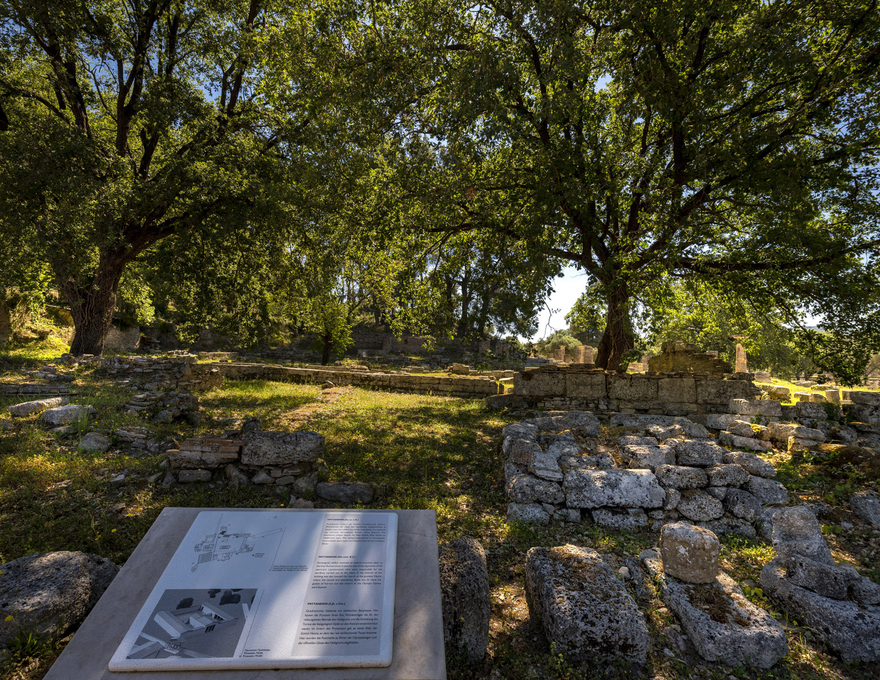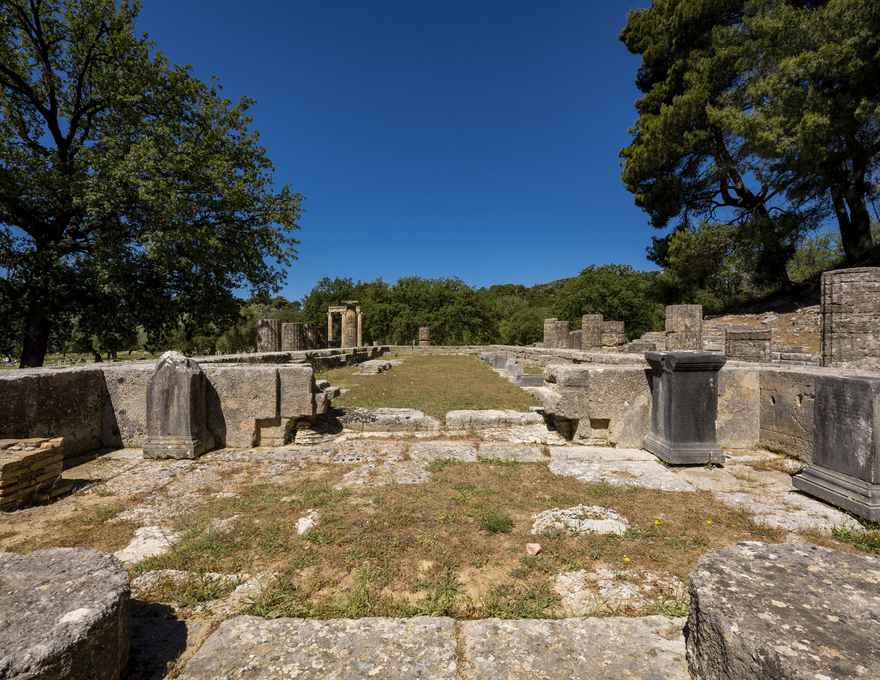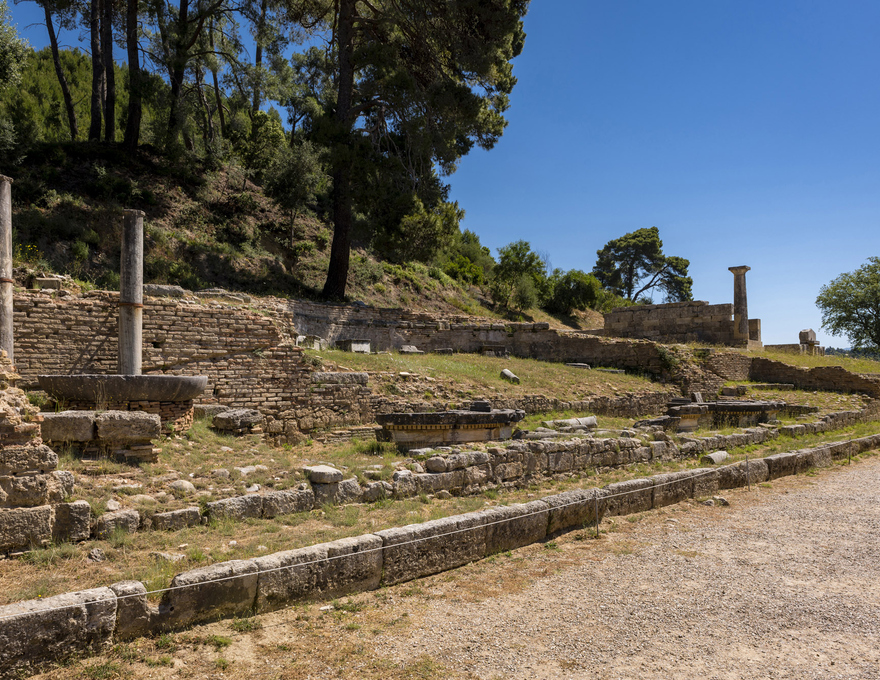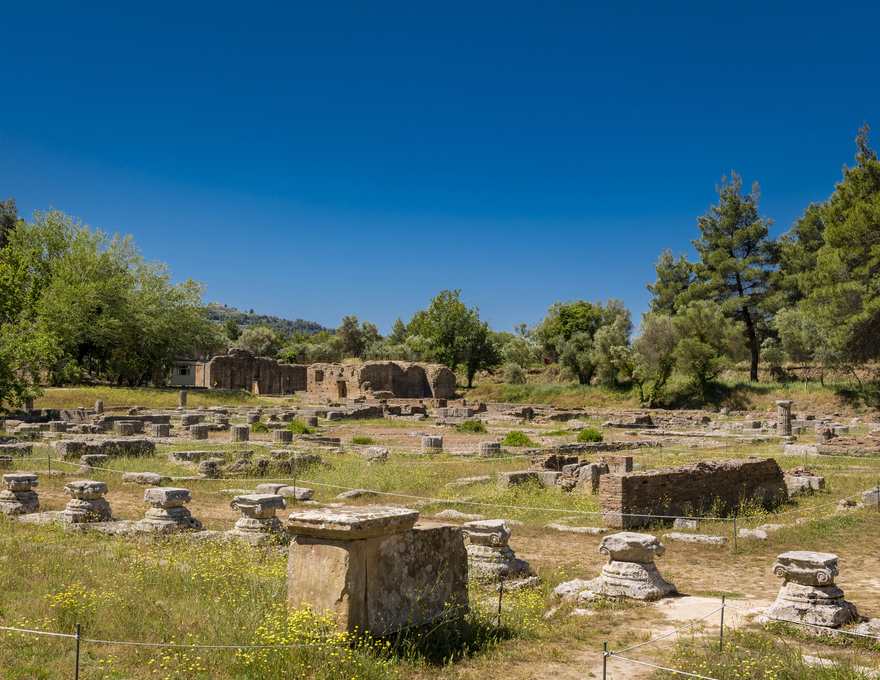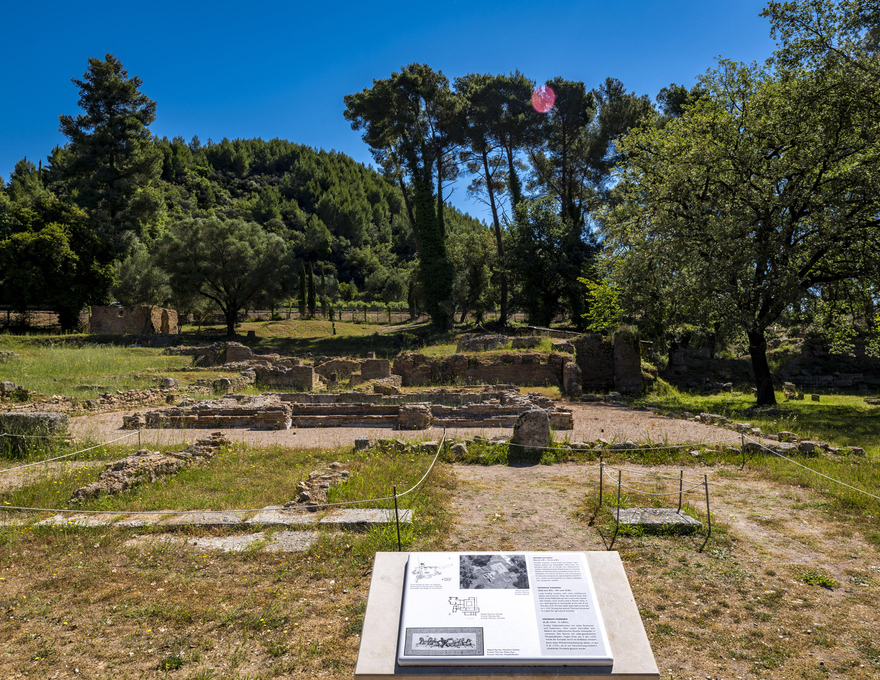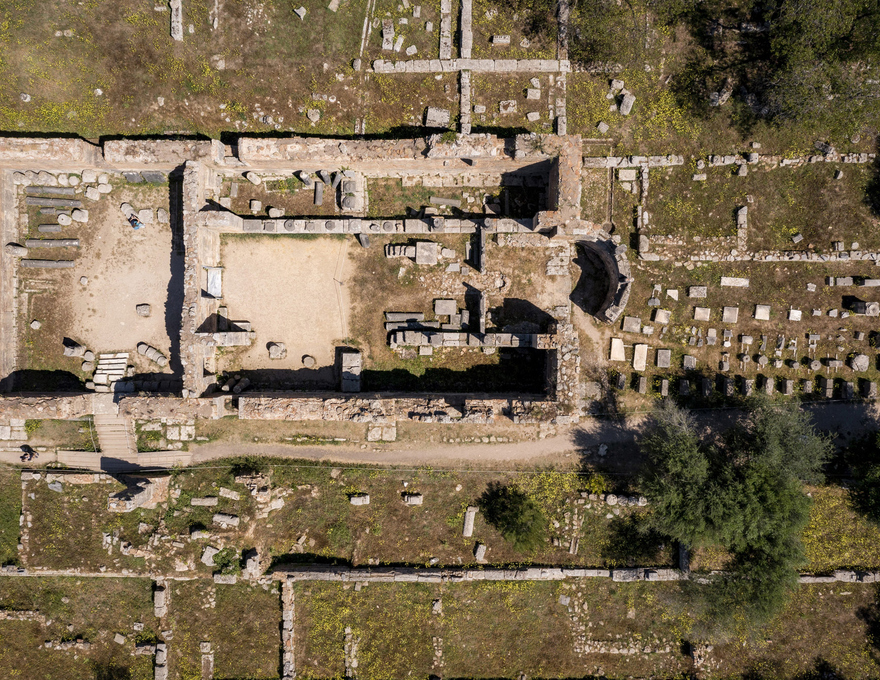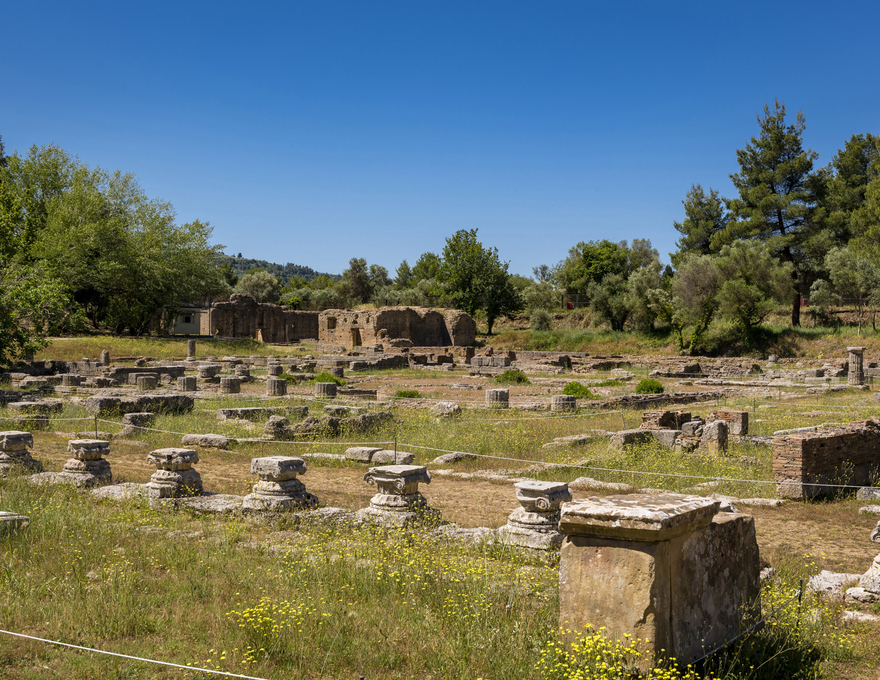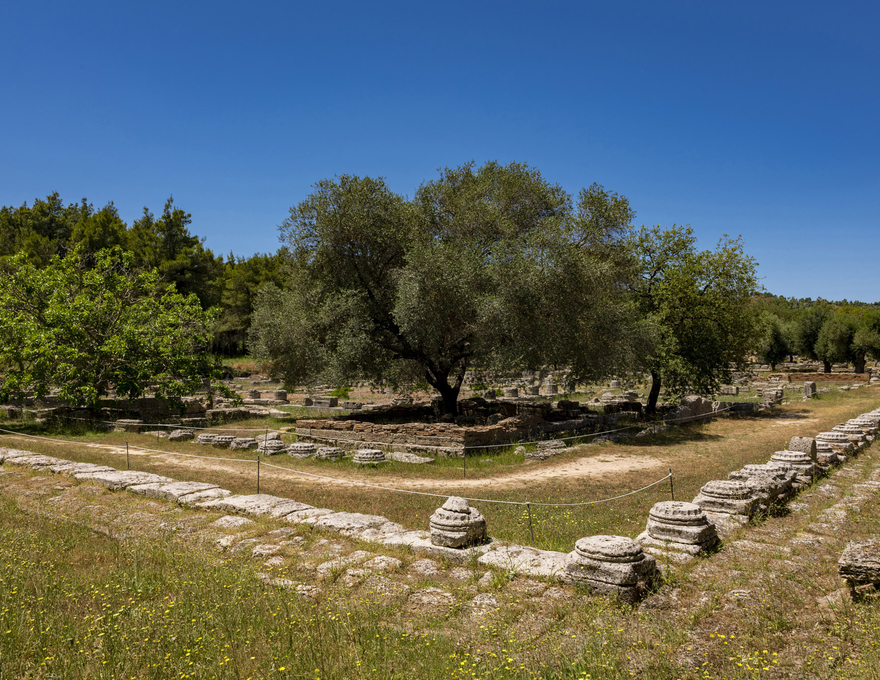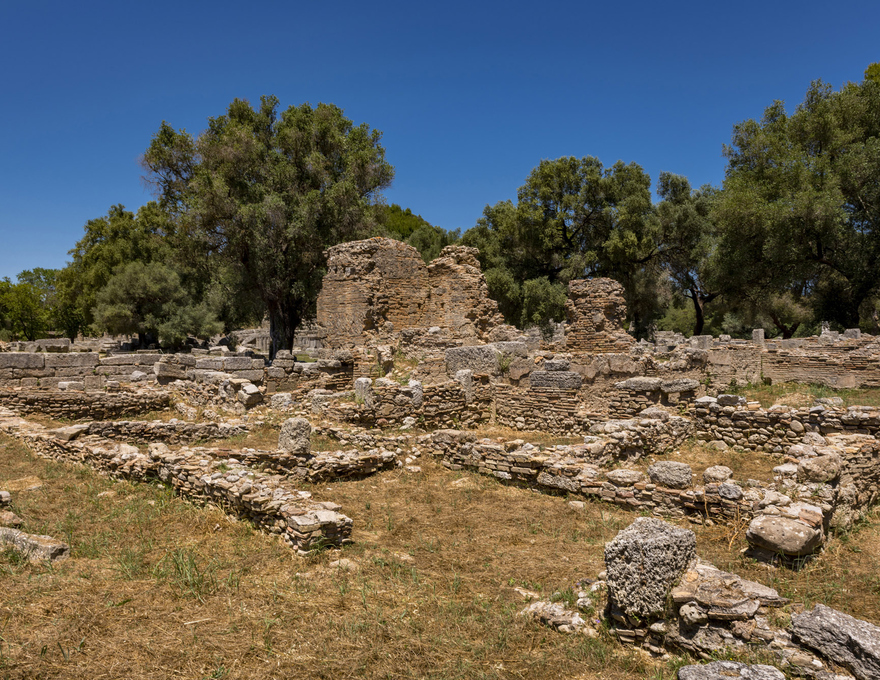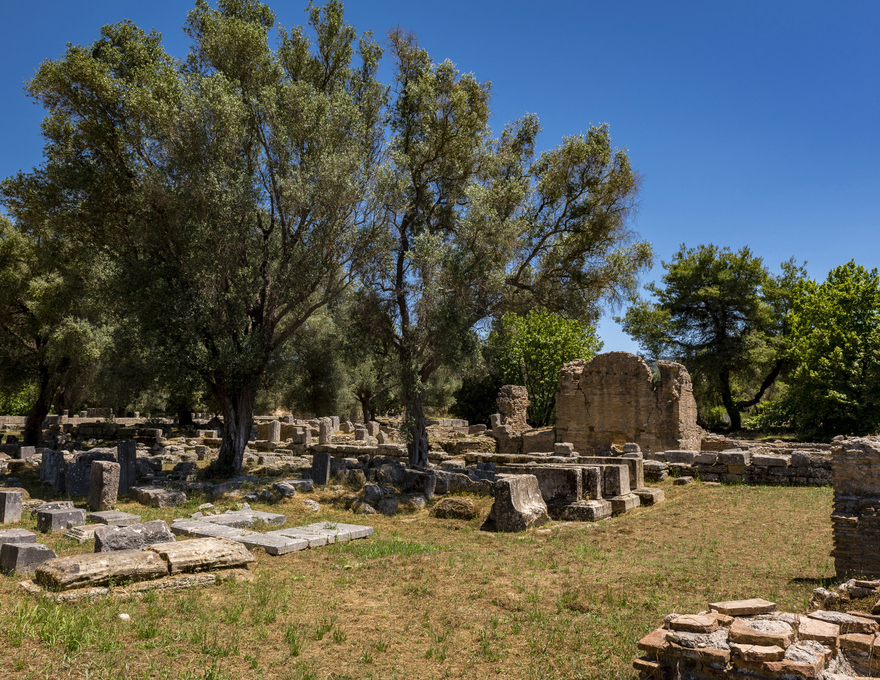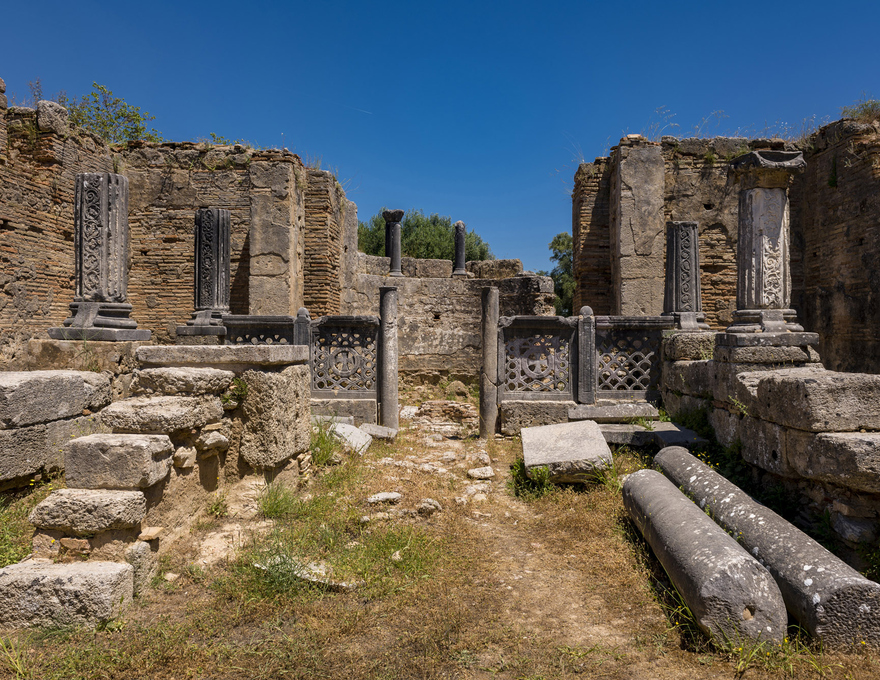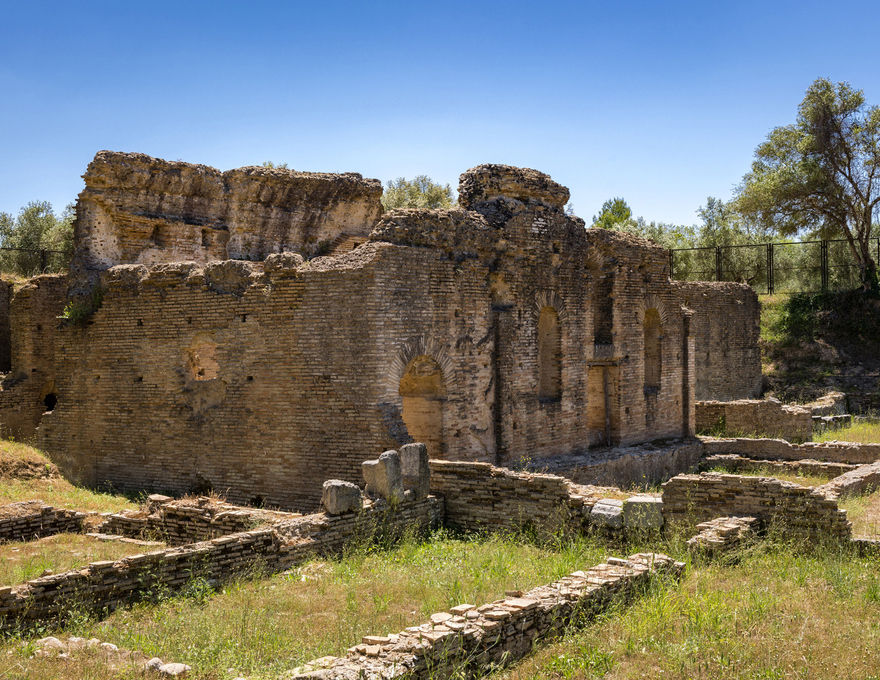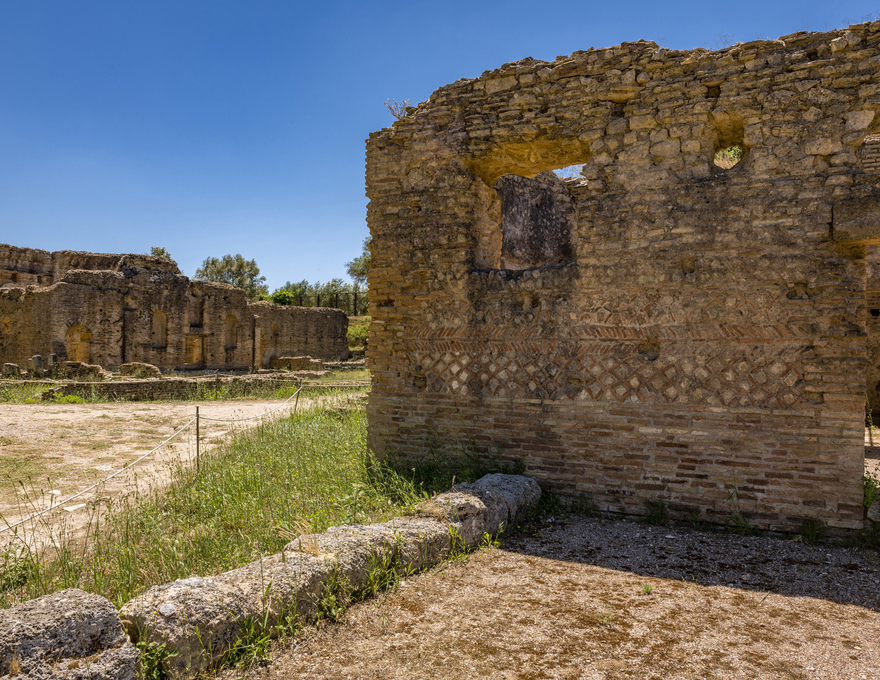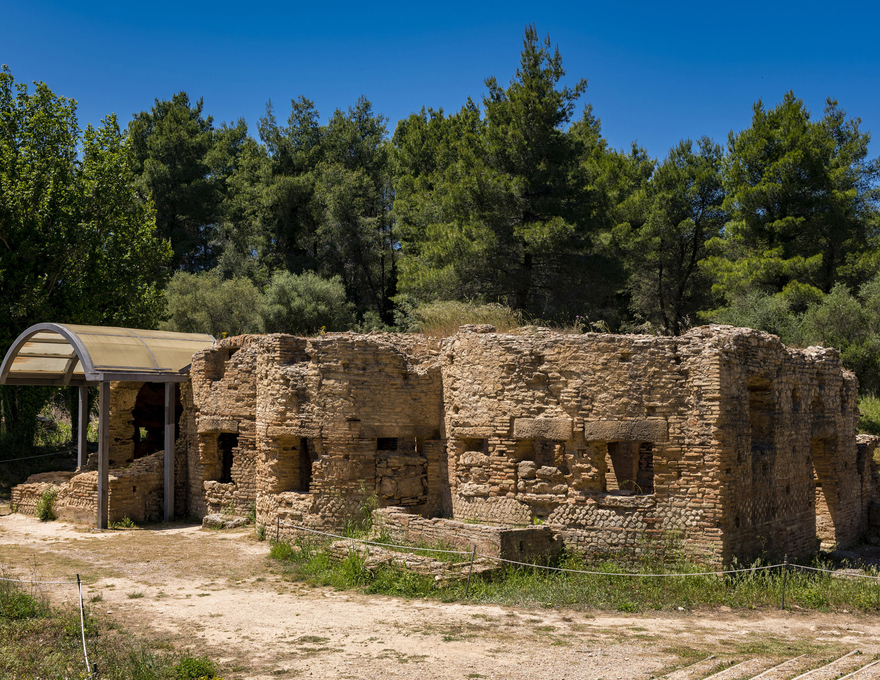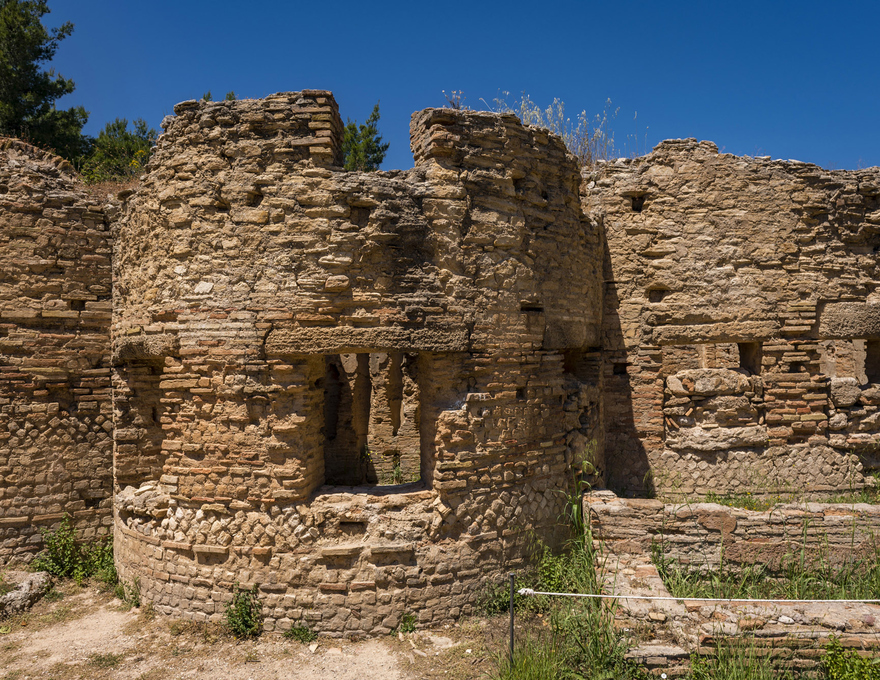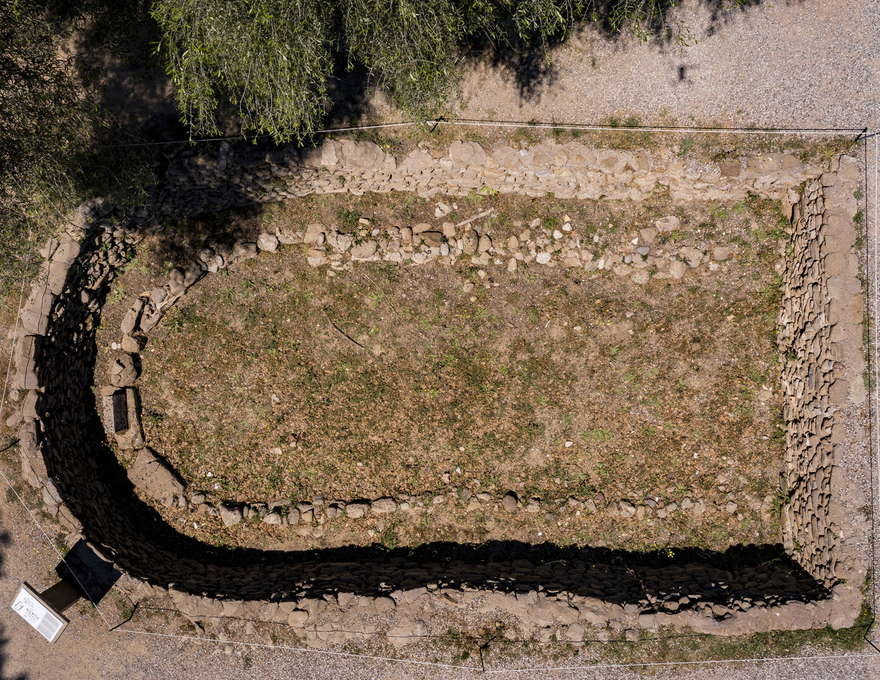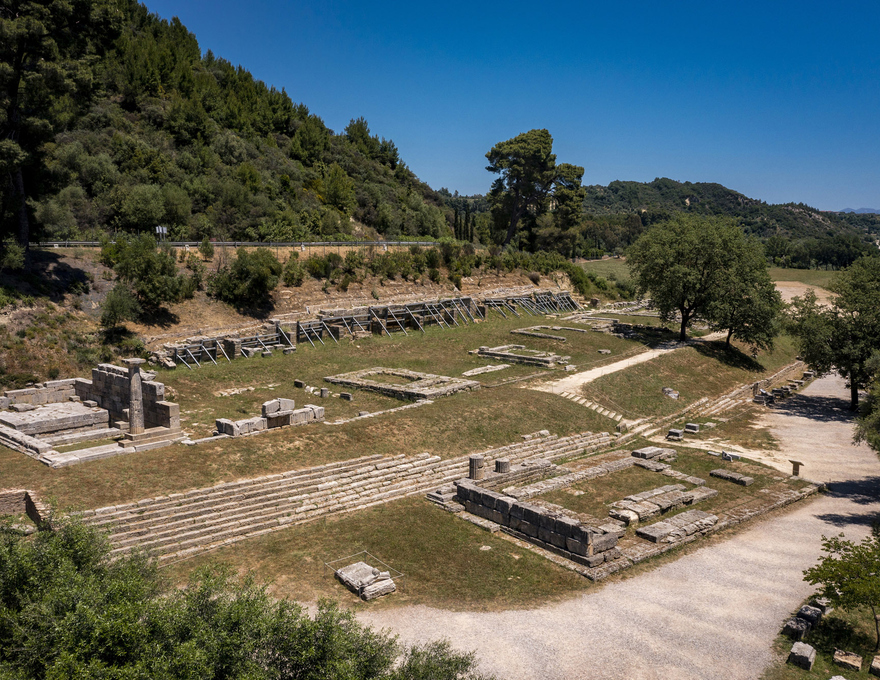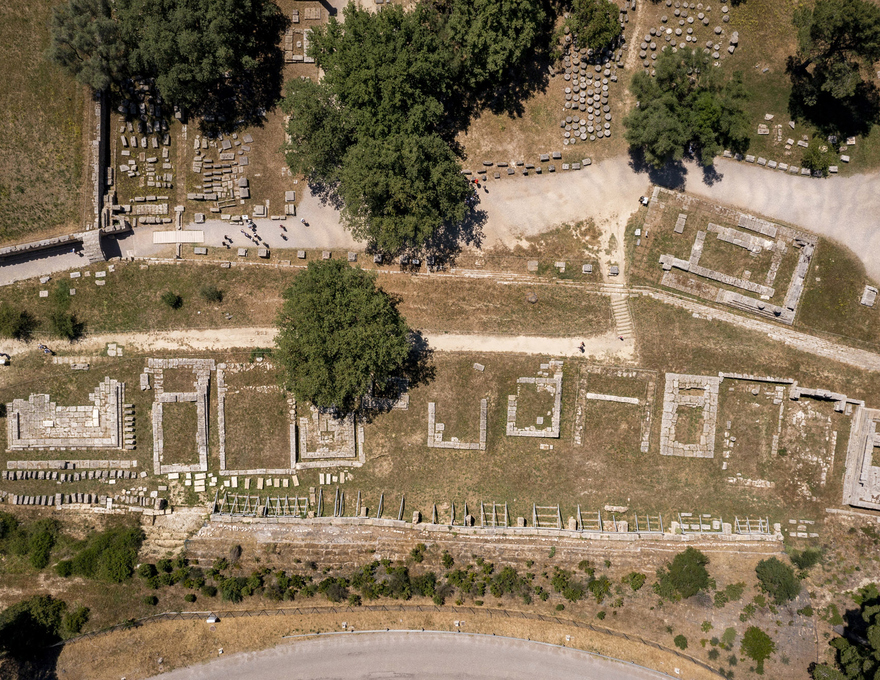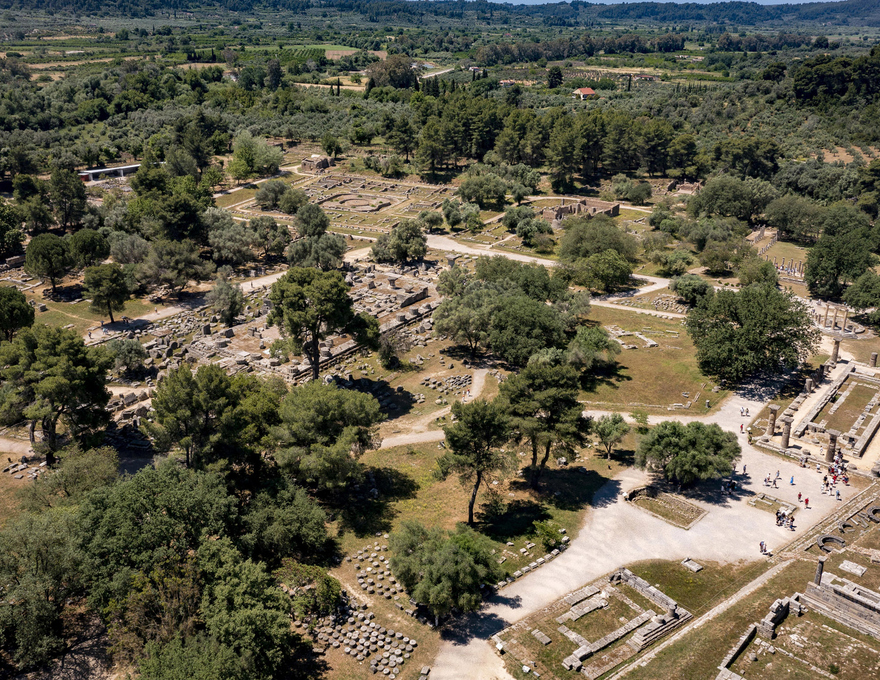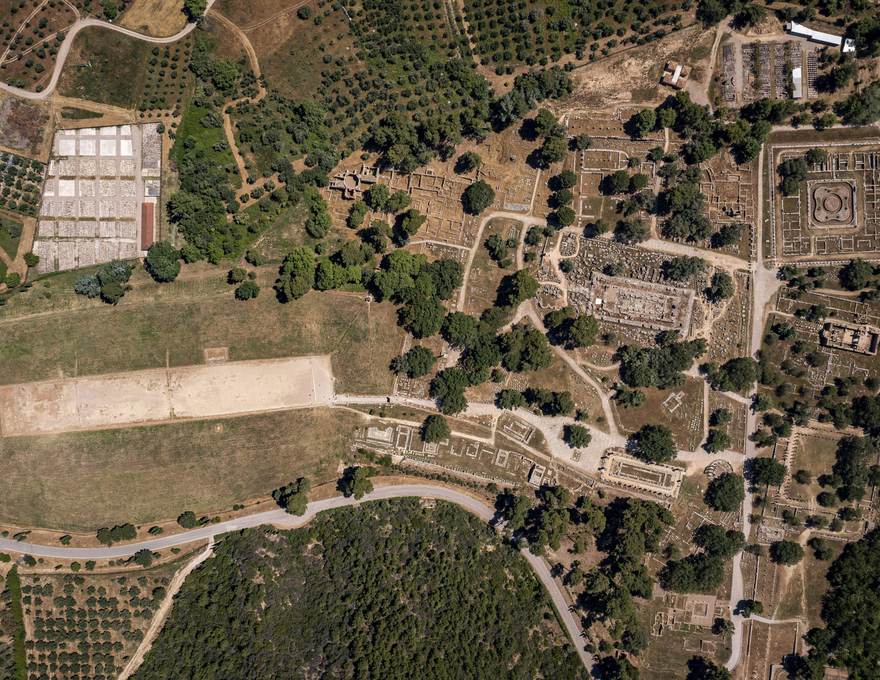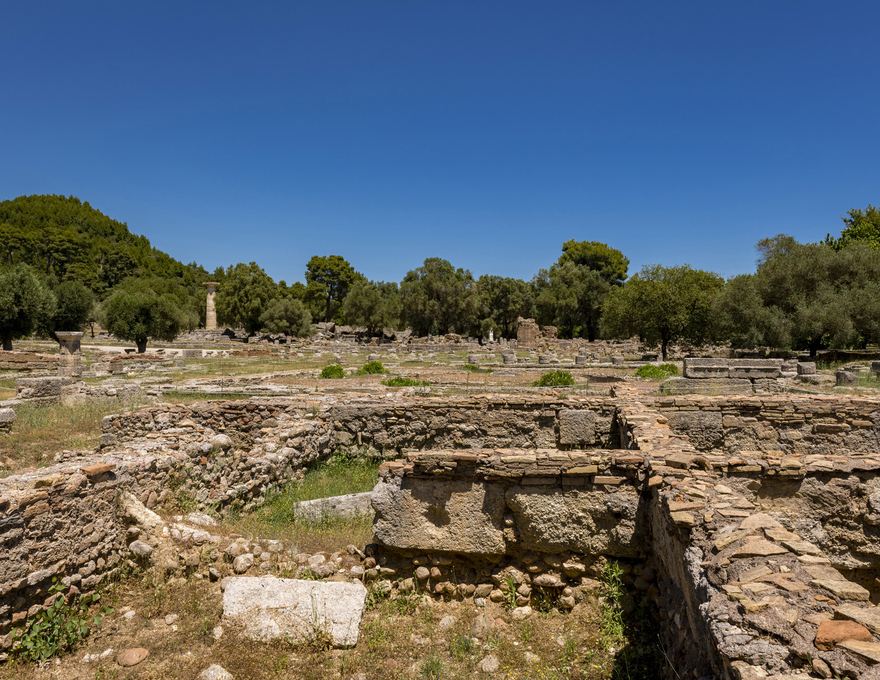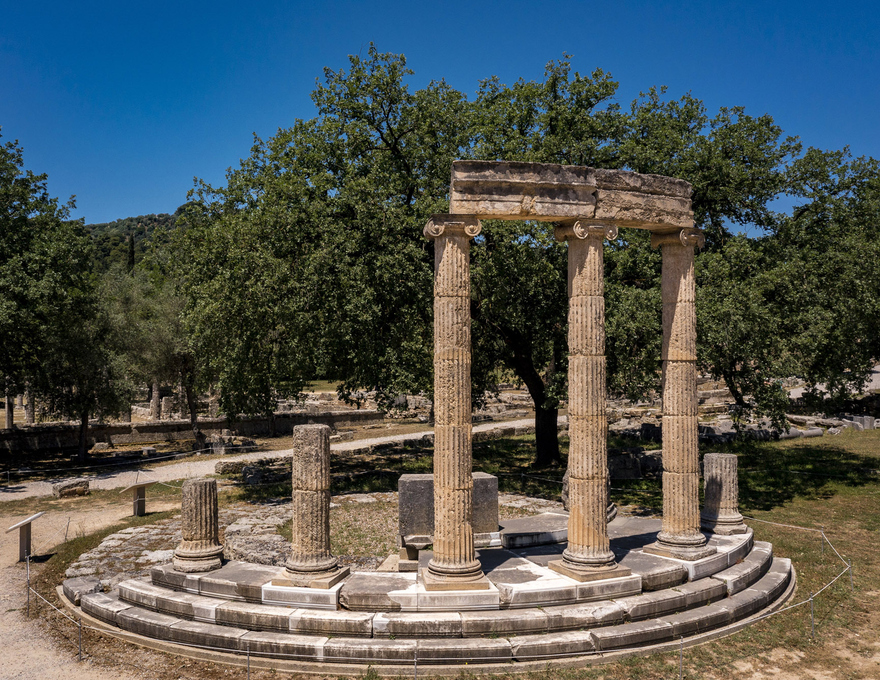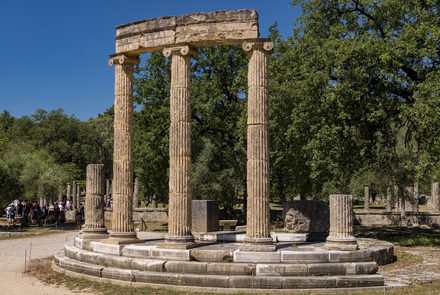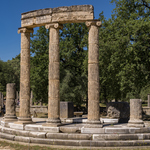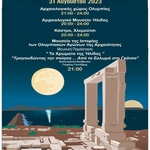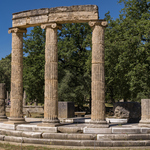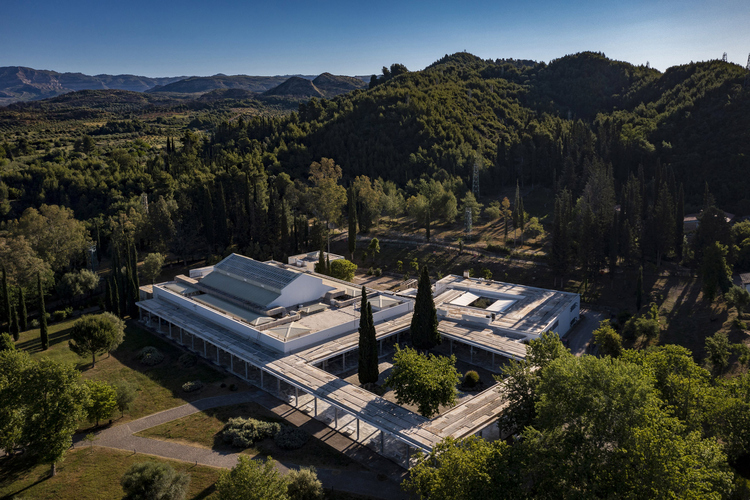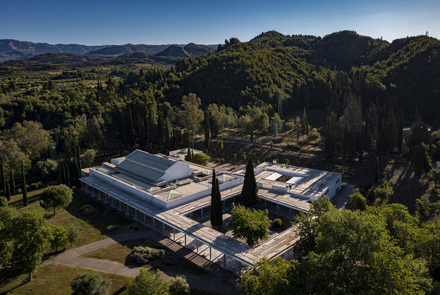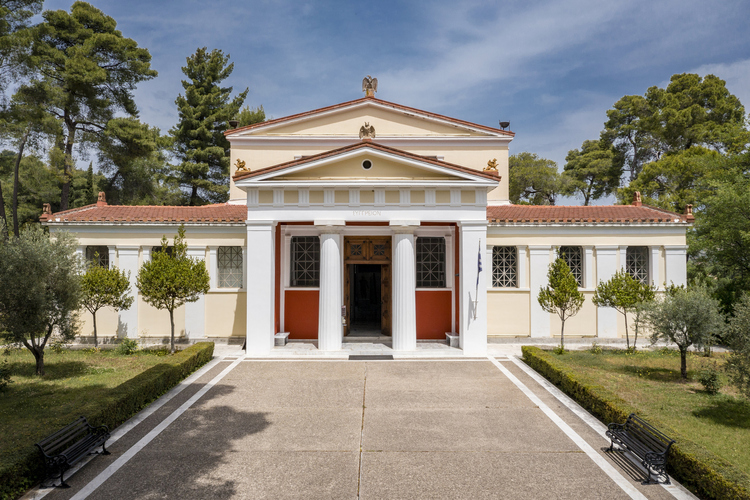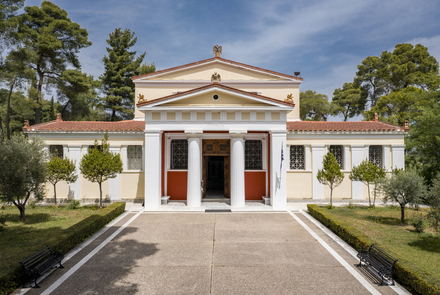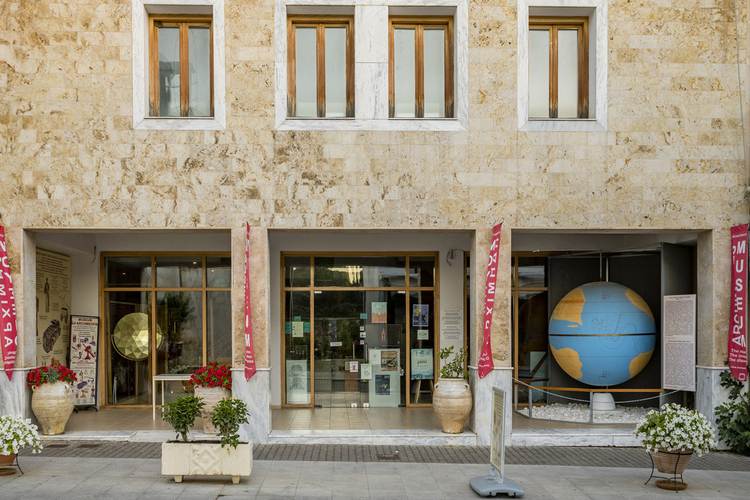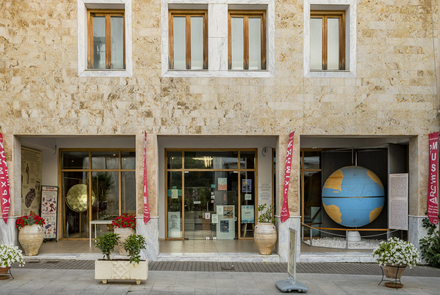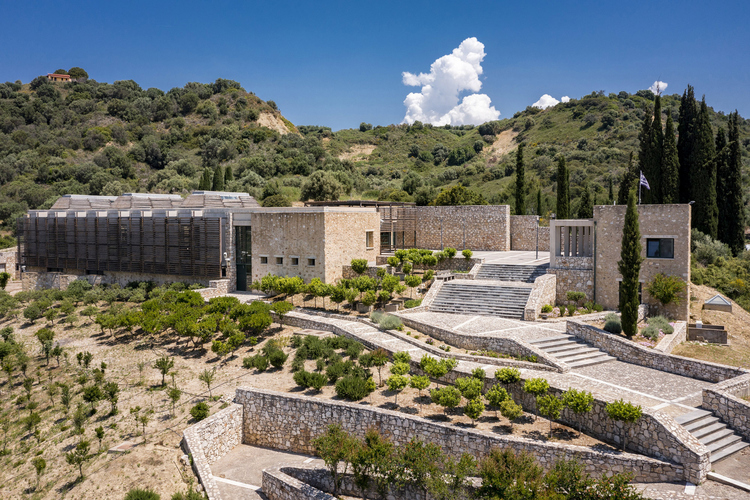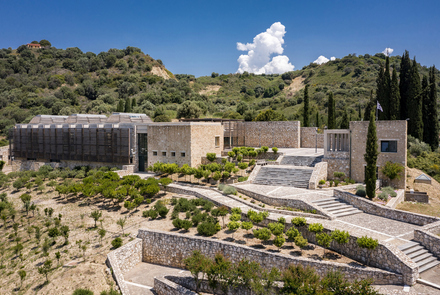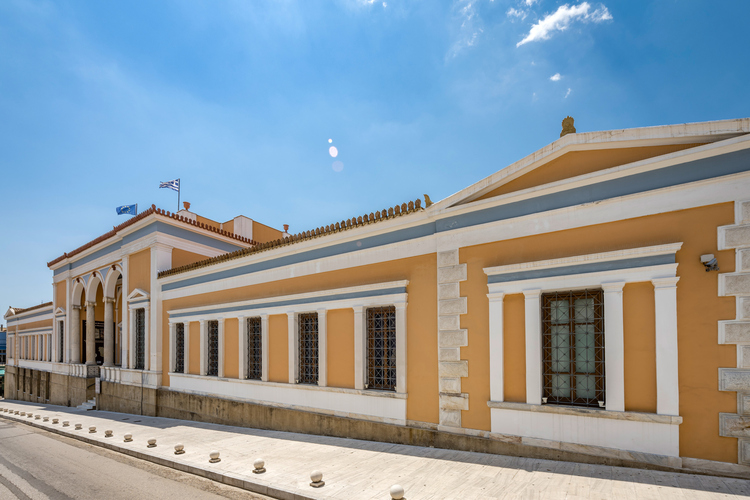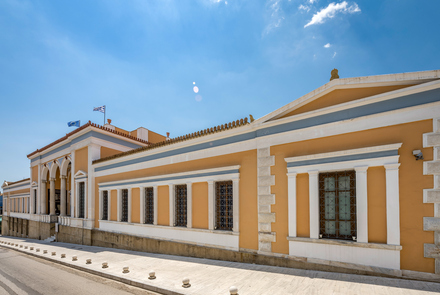Archeological Site of Ancient Olympia
In the beautiful valley of the river Alpheus in Olympia, flourished the most glorified sanctuary of ancient Greece, dedicated to the father of gods and men, Zeus. Here were born the most important Panhellenic games in honor of the god, the Olympics, which with their radiance and lustre illuminate humanity from ancient times until today.
The Sacred Altis, the sacred grove, in which the core of the Sanctuary is developed, is separated from the surrounding area by a precinct.
The magnificent Temple of Zeus (470-456 BC), the most important building of Altis in Olympia, the work of the architect Libon of Elis, dominates the sacred area in a prominent position. It is the largest temple in the Peloponnese which is considered the perfect expression of Doric temple architecture. Inside it was found the chryselephantine (:gold and ivory) statue of Zeus which was crafted by the famous Athenian sculptor Pheidias. In the Hellenistic period it was included among the seven wonders of the era.
At the opisthodomos of the temple of Zeus, one can see the place where the wild olive tree grew, from which every four years a child, whose parents were both alive, was called upon to cut the branches from which the kotinos was made, the wreath of the winners.
North of the temple of Zeus is the Temple of Hera, the goddess who was also worshipped in Olympia. According to the prevailing opinion, the temple was built around 600 BC while today it is considered one of the oldest examples of monumental temple buildings in Greece. Along with other valuable objects, in the temple was kept the disk of Iphitos, which had the text of the Sacred Truce engraved on it. In the Roman era, the temple was turned into a kind of museum, where some of the most valuable works of the sanctuary were kept, among which was one of the masterpieces of the classical period that survived to our time, the famous group of Hermes with the young Dionysus of the Athenian sculptor Praxiteles. In honor of Hera, the Heraia were celebrated, a festival organized by sixteen women of noble origin from Elis and other cities of the ancient state of the Eleans. The Heraia included girls’ road races in the stadium of Olympia and the awarding of a kotinos to the winner, corresponding to the Olympic Games, which were an all-male affair from which women were excluded.
In the area between the two temples there was the great Altar of Zeus, a very important monument, where on the fourth day of the Olympic Festival, every four years, the "hecatomb", i.e. the sacrifice of a hundred oxen, was conducted. Archaeologists found in the excavations of the Sacred Altis a thick layer of ash from the destroyed in late antiquity altar. The ashes were the remains of the repeated sacrifices which the responsibles of the sanctuary consolidated and incorporated as sacred on the altar of Zeus. The altar is not preserved today.
To the east of the temple of Hera is the Nymphaion, the brilliant aqueduct dedicated in the middle of the 2nd century AD to the sanctuary by Herodes Atticus, the function of which solved the chronic water supply problems of the Sanctuary. The Nymphaion was decorated with marble statues of remarkable art which were saved and are exhibited in the Archaeological Museum of Olympia.
On the same side was the Metroon, a Doric temple of classical times and of relatively small dimensions, dedicated to the mother of the gods Rhea-Cybele, which in Roman times was dedicated to the worship of the emperors.
Inside Altis there were also the Pelopion, a funerary monument dedicated to the hero Pelops, mythical founder of the Olympic Games, and the Philippeion, the elegant circular building dedicated by King Philip II of Macedonia, father of Alexander the Great, after the battle of Chaeronea (338 BC). Philip was even a three-time Olympic victor in the chariot races and equestrian contests held at the Hippodrome of Olympia.
At the foot of the Kronios hill, were located the Treasuries of the sanctuary of Olympia, temple-shaped buildings that had been built on a special terrace in the sanctuary by various Greek cities, mainly from the colonies of the Greeks, where they kept their precious tributes.
In the outdoor area of the sanctuary, among the temples and buildings, there was a multitude of statues of gods and heroes, statues of Olympic victors, tributes of famous individuals and Greek cities, many of which were saved and can be admired by the visitor at the Archaeological Museum of Olympia. Among them is the famous sculpture of the goddess Nike, messenger of Zeus, the work of Paionios, which was set on a high, marble pedestal opposite the eastern main face of the temple of Zeus, where the award ceremony of the Olympic victors took place.
In the western part of the archaeological site, the remains of buildings that served the athletes, the personnel of the sanctuary and the official visitors are preserved: the Gymnasium and the Palestra, the Theokoleon and the Leonidaion. Here is also located the Workshop of Pheidias, where the great sculptor worked for ten years, the Heroon as well as the remains of the baths, Roman thermae and later Roman hostels.
To the east of Altis stretches the Stadium of Olympia from the Classical era, which is connected to the sacred space through the Krypte Stoa, the sacred stone vaulted passage towards it. In ancient times, south of the Stadium there was also the Hippodrome, of which no trace survives today, because it has been washed away by the Alpheios river.
Other notable buildings of Olympia are the Echo Stoa, also known as the Stoa Poikile which separates the sacred space from the Stadium, Nero's mansion where the infamous Roman emperor stayed during his visit to the Sanctuary, the Bouleuterion which was the headquarters of the Olympic Council and where the sacred oath of athletes and judges was taken. Finally, the Prytaneion, in the NW corner of Altis, the seat of the Elean officials, where the unquenchable sacred flame burned on the altar of Hestia.
Over the centuries, the buildings of the area experienced many disasters, but they were repaired and reused. During Theodosius II's reign, the final destruction of the sanctuary occurred (426 AD) and in the middle of the 5th c. AD a small Christian settlement grew on top of the already ruined buildings. The sanctuary was affected by the earthquakes of the 6th c. AD that delivered the final blow causing the collapse of the great temple of Zeus.
The establishment of the Olympic Games in honor of Zeus goes back to the mythical era and is attributed to various heroes, the main ones being Pelops and Hercules. However, in the historical era they had stopped being held and after a related oracle from the Oracle of Delphi, they were reorganized in 776 BC by Iphitos, king of Elis.
Elis was in ancient times an important city of the Peloponnese in the fertile plain through which the river Pineios flows. It was the capital of the Eleans’ state which had under its guardianship the Sanctuary of Olympia and was responsible for organizing the great festival of the Greeks in honor of Zeus. Iphitos, together with the kings of Pisa and Sparta, Kleosthenes and Lykourgos, respectively, established the Sacred Truce, the great agreement that served as a protective shield against the frequent military confrontations between the Greeks, the pilgrims, the athletes and in general the institution of the sacred Olympics Games.
The Olympic Games continued to be held every four years without interruption until the first Christian years, when they were abolished by Theodosius I in 393 AD, after the 293rd Olympiad was held.
The invaluable archaeological treasures of Ancient Olympia remained buried in the earth until modern times and came to light gradually from 1875 onwards, following the extensive, systematic excavations and other archaeological researches carried out by the German Archaeological Institute to this day.
The operation, maintenance and general supervision of the site belongs to the Ephorate of Antiquities of Ilia of the Ministry of Culture.
The Archaeological Site of Olympia has been registered in the UNESCO World Heritage List since 1989, while it is protected as well as the wider area by the Natura 2000 Network.
Copyediting: Ephorate of Antiquities of Ilia
Ancient Olympia can be reached by train from Katakolon and Pyrgos, by bus and by private vehicle. The museum is located in a central part of Ancient Olympia.
Full price: €20, Reduced: €20
From April 1st to October 31st, the integrated ticket, valid for one day, is 12 euros (reduced ticket 6 euros) and includes entrance to the following areas:
- Archaeological Site of Olympia
- Archaeological Museum of Olympia,
- Museum of the History of the Olympic Games of Antiquity
- Museum of the History of the Excavations in Olympia.
- Ιndividual tickets (per area of interest) are no longer issued.
The following categories of visitors are entitled to 50% reduced admission
- Greek citizens and citizens of other European Union member states over 65 years of age, upon presentation of their police ID or passport to confirm age and country of origin, during the period from October 1st to May 31st of each year.
- Parents accompanying primary education schools visits from EU member-states and the European Economic Area.
- Accompanying teachers of educational visits of schools and institutions of primary, secondary and tertiary education from non European Union countries.
Free admission - Exemption from the obligation to pay a price
1. Entrance to organized archaeological sites, historical sites, monuments and museums that belong to the State and are managed by the Ministry of Culture is free, without payment of a fee, on the following dates:
- March 6th (Melina Mercouri Memorial Day),
- April 18th (International Monuments Day),
- May 18th (International Museum Day),
- Last weekend of September (European Heritage Days fortnight),
- October 28th (National Holiday)
- First and third Sunday of each month from November 1st to March 31st of each year.
2. The following categories of visitors are entitled to free admission :
- Children and young people up to the age of 25, from EU member-states, upon presentation of their ID card or passport for verification of their age and country of origin.
- Children up to the age of 18, from non-European Union countries, upon presentation of their passport for verification of their age and country of origin.
- Persons over 25 years, being in secondary education (evening schools, second-chance schools) and in vocational schools from EU member-states and countries of the European Economic Area, upon presentation of attendance certificate bearing evidence of its duration.
- Accompanying teachers and learners during educational visits of schools and institutions of primary, secondary and tertiary education from EU member-states and countries of the European Economic Area.
- People entitled to Social Solidarity Income and members dependent on them, upon presentation of their ID card and certificate of free entry based on eligibility to the programme showing the duration, as well as a valid document certifying dependent members.
- Greek unemployed citizens upon presentation of their ID card and valid unemployment card or recent renewal of it.
- Persons with disabilities and one escort (only in the case of 67% disability), irrespective of the country of origin, upon presentation of their ID card or passport and Disability Certificate issued by the Single Body of Social Insurance (decision of the Disability Certification Center-KEPA) for Greek citizens or similar certificates issued by a corresponding authorized foreign body.
- Greek parents of families with many children, the children being up to the age of 25 and irrespective of age if they have disabilities, upon presentation of their ID card and a valid certificate of a large family status by the Greek Supreme Confederation of large family parents and the Disability Certificate (issued by the Disability Certification Center).
- Greek parents of families with three children, the children being up to the age of 25 and irrespective of age if they have disabilities, upon presentation of their ID card and a valid family status certificate issued by the Municipality and the Disability Certificate (issued by the Disability Certification Center).
- Greek single parent families with children up to the age of 25 and irrespective of age if they have disabilities, upon presentation of their ID card and a valid family status certificate issued by the Municipality and the Disability Certificate (issued by the Disability Certification Center).
- Refugees, upon presentation of the International protection applicant card or a Travelling document of the 28th July 1951 Convention (a passport of recognized refugee) or a Foreign travelling document (a passport of recognised holder of subsidiary protection) or residence permit.
- Greek citizens performing their military service, with valid military service identification card.
- Greek -Olympic Winners upon presentation of their ID card and membership card of the Hellenic Olympic Winners Association.
- Official guests of the Greek State, after request of the competent Ministry (Directorate/Office for Protocol) and approval by the General Directorate of Antiquities and Cultural Heritage.
- Members of the International Council of Museums (ICOM) and International Council of Monuments and Sites (ICOMOS), upon presentation of their ID card or passport and their valid membership card.
- Members of Societies and Associations of Friends of State Museums and Archaeological Sites, managed by the Hellenic Ministry of Culture and Sports, upon presentation of their valid membership card.
- Active employees of the Hellenic Ministry of Culture and Sports, the Archaeological Resources Fund, the Acropolis Museum and the Kanellopoulos Museum, upon presentation of their service ID card.
- Scientists licensed for purposes of photographing, studying, designing or publishing antiquities, upon presentation of the relevant license.
- Members of the Chamber of Fine Arts of Greece, upon presentation of their valid membership card.
- Greek tourist guides, upon presentation of their professional ID card.
- Journalists, upon presentation of a valid journalist ID card
- Holders of a three-year Free Entry Pass.
- Members of the Association of Greek Art Historians, upon presentation of their valid membership card.
3. The following categories of visitors are entitled to obtain a three-year Free Entry Pass -retaining the right of renewal- issued by the competent Services of the Hellenic Ministry of Culture and Sports :
- Active members of the Central Councils and Regional Councils of Monuments of the Hellenic Ministry of Culture and Sports.
- Active members of the Board of Directors of the Archaeological Resources Fund, the Acropolis Museum and the Kanellopoulos Museum.
- Active Directors and members of Foreign Archaeological Schools in Greece.
- Contract employees of the Hellenic Ministry of Culture and Sports, the Archaeological Resources Fund, the Acropolis Museum and the Kanellopoulos Museum. Renewal of the free pass is possible if they continue to be employed by the Ministry of Culture and Sports, the Archaeological Resources Fund, the Acropolis Museum and the Kanellopoulos Museum.
- Retired employees of the Hellenic Ministry of Culture and Sports, the Archaeological Resources Fund, the Acropolis Museum and the Kanellopoulos Museum.
- Civil Servants in the Legal Advisor Office of the Hellenic Ministry of Culture and Sports.
- Greek active teachers in primary, secondary and tertiary education. In the case of substitute/hourly teachers, renewal of the free pass is possible if they continue to be employed as teachers.
- Graduates of Departments of History and Archaeology of Schools of Philosophy, as well as graduates from Schools of Architecture, Fine Arts, Conservation of Antiquities and Works of Art, including Technicians of Conservation of Antiquities and Works of Art from Greece or from equivalent Schools of EU member-states and the European Economic Area, as well as holders of Master's or PhD Degrees from those Schools and Departments.
- Graduates of Museum Studies programmes and Schools and Departments of Cultural Management of Higher Education Institutions in Greece or equivalent Institutions of EU member-states and the European Economic Area, as well as holders of Master's or PhD Degrees in those studies.
- Students and graduates of the Preparatory and Vocational School of Fine Arts of Panormos Tinos.
- Police officers of the Department of Cultural Heritage and Antiquities of Security Directorates.
Holidays
- 1 January: closed
- 25 March: closed
- Good Friday: 12:00-17:00
- Holy Saturday: 8:00-15:00
- 1 May: closed
- Easter Sunday: closed
- 25 December: closed
- 26 December: closed
- The archaeological site of Ancient Olympia is located in Municipality of Ancient Olympia P.C. 27065
- 2624022742 - 2624023753 (Ephorate of Antiquities of Ilia)
- Police Department of Ilia - P.D. of Ancient Olympia, Ephorate of Antiquities of Ilia
Winter (November - March) :
08:30 a.m. - 03:30 p.m.
Summer (April - October) :
From 1st of April until 31 of August 08:00 - 20:00
Last entrance to the Site at 19:30
On the 1st of September the opening hours apply, due to a gradual reduction in the length of the day, as follows:
1st to 15th September 08:00 - 19:30
Last entrance to the Site at 19:00
16th to 30th September 08:00 - 19:00
Last entrance to the Site at 18:30
1st to 15th October 08:00 - 18:30
Last entrance to the Site at 18:00 and
16th to 31st October 08:00 - 18:00
Last entrance to the Site at 17:30

